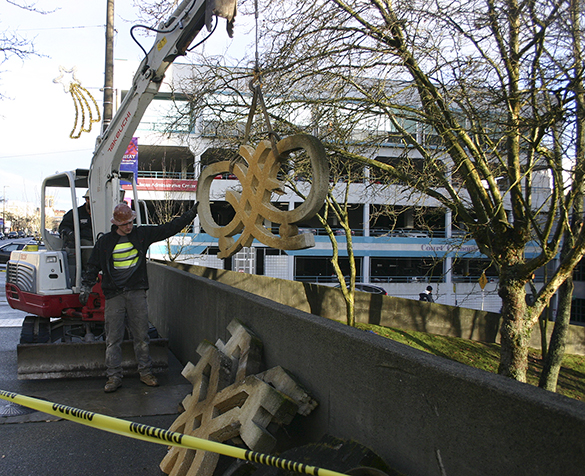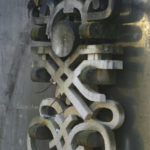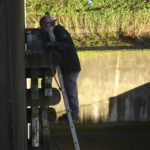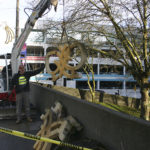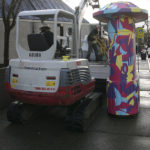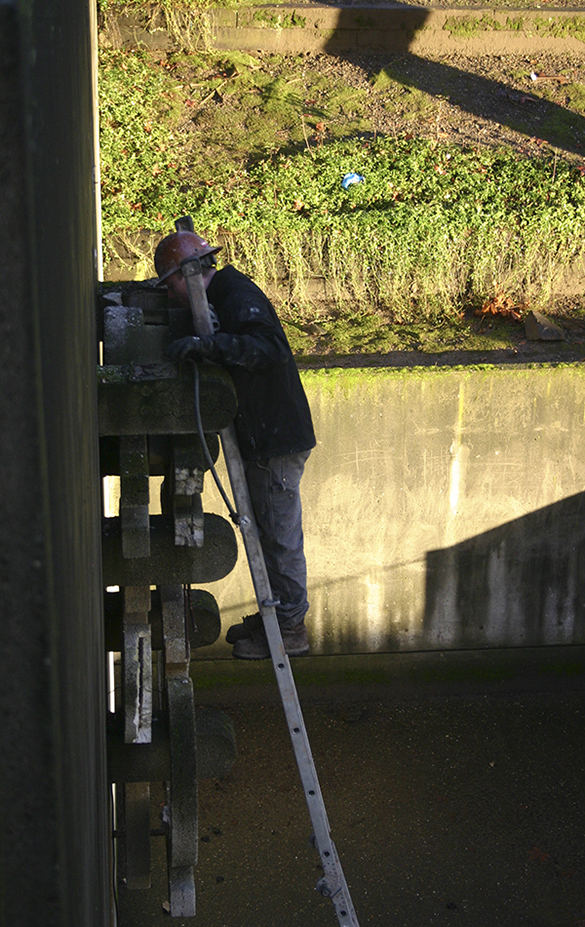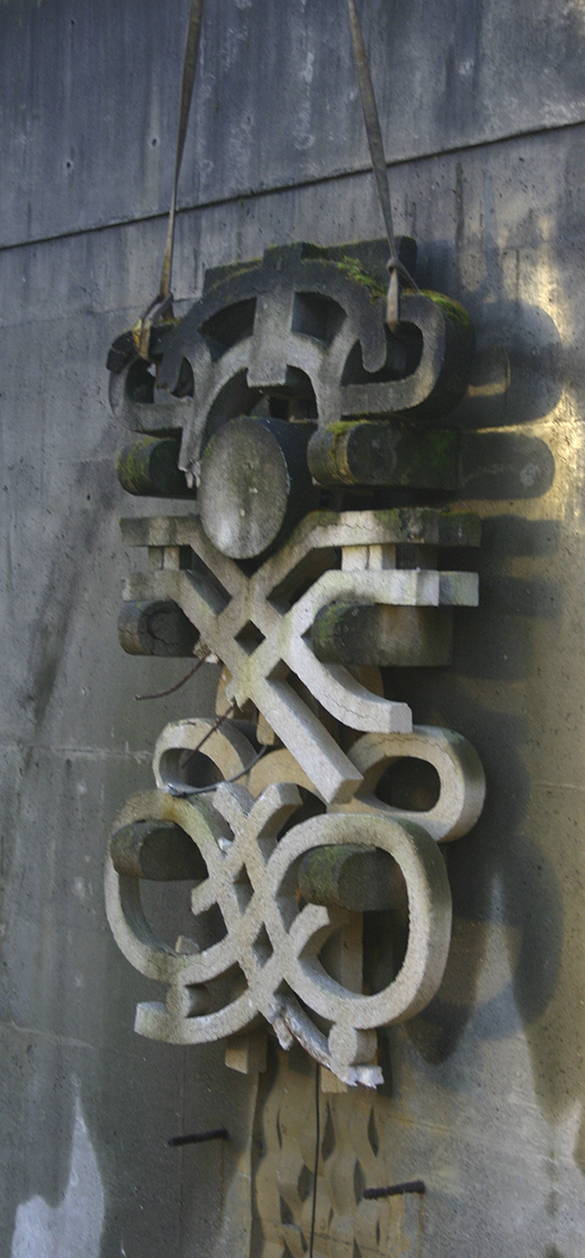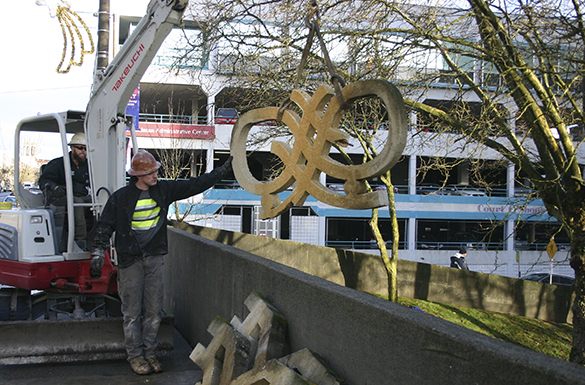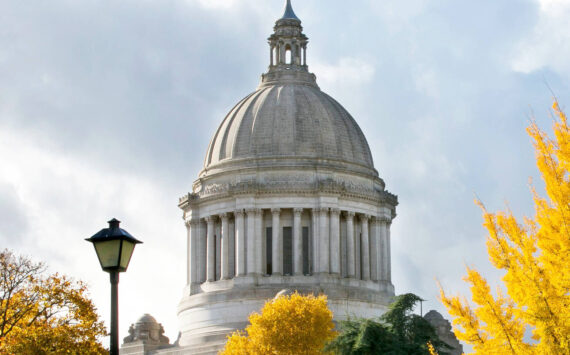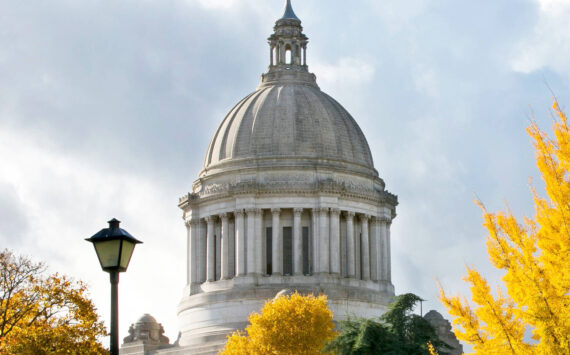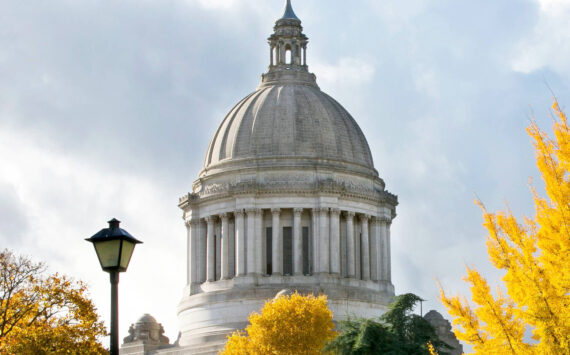A downtown Tacoma art installation created 40 years ago by a prominent Pacific Northwest artist was removed this week.
The abstract, wall-mounted, and untitled concrete sculpture was commissioned by Bob Price Architecture Co. and created by Harold Balazs in 1976 as part of a courtyard fountain at the Bicentennial Pavilion located near South 13th Street and Market Street.
Photographs archived at the Tacoma Public Library’s Northwest Room show the sculpture displayed prominently in a pocket park filled with visitors. Today, the park is tucked away behind the high-rise Hotel Murano, the South 13th Street hillclimb, and a massive wall where the sculpture sat for decades. Water damage and vandalism left the artwork broken and moss-covered, with jagged pieces of rebar exposed.
“Even in its dilapidated state, the work nevertheless retains a powerful presence,” wrote Tacoma Weekly reporter Dave R. Davison in 2010. “Presiding over a pool of stagnant rainwater, the sculpture has the air of a Mayan monument — some ancient Central America king with an elaborate headdress. The thing is anthropomorphic and the style seems a perfect synthesis of Mesoamerican, Asian, and Celtic design elements.
“The whole site is like a secret, enchanted valley amid the urban landscape,” continued Davison. “The place is all the more mellow and restful, perhaps, because it has had time to age and to show the mossy passage of time. Balazas’ fountain sculpture is one of Tacoma’s many hidden treasures.”
“I love this park. It’s so sweet. It’s a little gem of downtown and this piece was also a little gem,” said City of Tacoma Public Art Specialist Rebecca Solverson on Wednesday morning as she supervised the de-installation process. Two men working for Combined Construction, a contractor hired by the City of Tacoma to complete the removal project, used a mechanical excavator’s long arm to carefully pluck six concrete pieces off the side of the wall. At one point, a friend of Balazs’s arrived to see if he could salvage any of the pieces. After a quick look at the busted pieces lined up along the sidewalk, he agreed nothing was worth saving.
A recent City staff report noted the artwork was “unstable and pose[d] a safety hazard.” A consultant reviewed the artwork several years ago and recommended it for de-accession. The Tacoma Arts Commission voted in April to de-accession the artwork.
“People were climbing it,” City of Tacoma Arts Administrator Amy McBride told the Tacoma Daily Index in November (see “Safety concerns force Tacoma to remove aging art installation downtown,” Tacoma Daily Index, Nov. 6, 2015; and “Tacoma Daily Index Top Stories — November 2015,” Tacoma Daily Index, Dec. 1, 2015). “I love Harold’s work. Unfortunately, he was working in a material that isn’t particularly durable after thirty years. But it had a good run! Close to forty years!”
“People have told me that it has suffered quite a high degree of vandalism,” Balazs, 87, told the Tacoma Daily Index in November during a telephone interview from his home in Mead, Wash.
Balazs’s work is on display throughout Washington State, including Riverfront Park in Spokane; the Federal Building in downtown Seattle; the Temple Beth El synagogue building in Tacoma; and the former Puget Sound Bank (now KeyBank) in University Place. Six years ago, University of Washington Press published a book about Balazs that coincided with exhibits of his work at museums in Spokane, Pullman, and La Conner.
“I just had a couple more pieces that have been vandalized and torn down,” Balazs told the Tacoma Daily Index. “Nobody wants to repair them.” He recalled the artwork originally included water and light features. “I very seldom gave any titles to the work I did. I know that was the case there. I think somebody was going to try and salvage it and just use it in their home, but I guess that hasn’t come to pass.
“It’s just what happens with age,” he added. “In the old days, they repaired stuff. But the lifetime endurance of most buildings is twenty-five years. Very little gets saved anymore. It’s thrown in the dump.”
In November, four contractors responded to the City of Tacoma’s call for bids to remove and dispose of the art installation: Combined Construction — $3,300; T. Miller Construction — $3,580; Woodland Industries — $3,650; and Nordic Construction — $3,939 (see “4 contractors bid on project to remove aging art installation downtown,” Tacoma Daily Index, Dec. 3, 2015; and “Tacoma Daily Index Top Stories — December 2015,” Tacoma Daily Index, Jan. 4, 2016). A contract was awarded to Combined Construction (see “Last days for aging downtown Tacoma art installation,” Tacoma Daily Index, Jan. 14, 2016).
The Tacoma Daily Index spoke with Solverson on Wednesday morning while contractors removed the sculpture.
TACOMA DAILY INDEX: What is happening today with Harold Balazs’s sculpture?
REBECCA SOLVERSON: This piece is being deaccesioned, which is when we formally take it out of the collection. It went through a process with the Arts Commission to give us authority to remove it. If there is a piece that is a safety concern or we are losing the site or for whatever reason we need to take it out of the collection or can’t care for it anymore, we will let the artist know that it is being considered for de-accession and we will bring it in front of the Arts Commission or a panel to look at it, and then that recommendation will go to the Arts Commission. In this case, we sent it straight to the Arts Commission because it was kind of a timely matter. Then we let the artist know that it was de-accessioned. Artworks have some rules around them. Artists have copyright protection around their work so we offer it back to the artist first. They are allowed to come and get their artwork if they want it. They have first right of refusal. In this case, Harold is living across the state and wasn’t able to come get it. He asked if his friend could come and pick up part of it, which didn’t work out. If the artist doesn’t want it, we have a couple options. Usually we destroy it so that no one else can come pick it up out of a Dumpster.
INDEX: Is that what is going to happen with this piece? Will it just be destroyed?
SOLVERSON: Yes. A big reason why this piece is being removed is because it’s pretty dangerous. It has rusty rebar sticking out of it.
INDEX: How did it get to this point?
SOLVERSON: Water damage. It’s really old. It was commissioned in the 1970s. I think it was a fountain at one point, which is not what it should have been. For most artwork, water is the enemy. A lot of artists aren’t actually thinking their work is going to last forty or fifty years. The Washington State Arts Commission has a thirty year lifespan standard. This piece has outlived that. We try to save them, but in some cases it’s just — we would have to rebuild the whole piece at this point. That’s really not fair for the artist.
INDEX: When I spoke to Harold by telephone, he didn’t seem too concerned about it being lost. Is that your impression, too?
SOLVERSON: I think he’s had a lot of pieces this age. Some of them have been preserved if they are able to, depending on where they are or if they are covered. He was upset. It’s his artwork. It’s a great piece. He has memories associated with it. But I think he also understands this is what happens. I think this is happening, frankly, with a lot of his work. I love this park. It’s so sweet. It’s a little gem of downtown and this piece was also a little gem. But the bottom piece had already fallen off or someone had taken it. I’ve been here before and there has been trash in it that people have thrown. It’s really sad.
INDEX: Is this a unique situation for Tacoma to have to de-accession and destroy a piece of art?
SOLVERSON: It is. We don’t do this very often. A lot of times we de-accession because it’s a piece that has been lost, stolen, or there is serious damage. Our job is to be good stewards of the pieces in the collection. If there is a piece that is going to cost so much to repair it that it takes away from other parts of the collection, then it’s good collection management to de-accession it.
Todd Matthews is editor of the Tacoma Daily Index, an award-winning journalist, and the author of several books. His journalism is collected online at wahmee.com.
